
In the hot, dry summer of 2018, we had a fantastic day helping the Calderdale community celebrate the installation of flood defences! On such a beautiful day, enjoying the entertainment from the Calder Valley Youth Theatre and Hebden Bridge Junior Band, it was almost hard to remember that we were there to talk to the community about why the Slow The Flow: Calderdale group are working so hard to raise awareness of Natural Flood Management (NFM) and Sustainable Drainage Systems (SuDS).
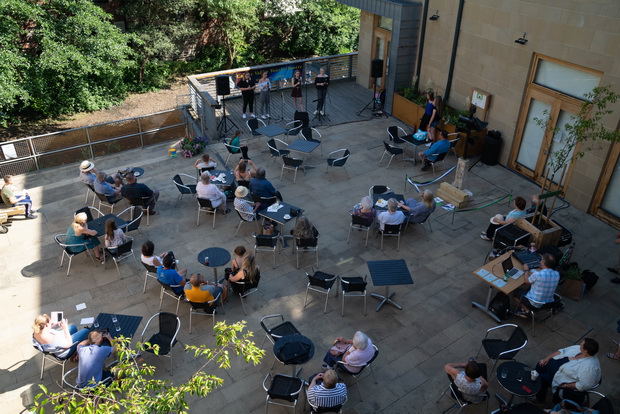
Image: Rain garden planter launch party, seen from balcony (credit: Matt Radcliffe Photography).
The 'You Can Slow The Flow' project is designed to inform and empower the local community to make small changes in their own urban environment with the overall aim of slowing the flow of heavy rainfall events. This could have a big impact in the Calder catchment, which is described as ‘flashy’, meaning it responds dramatically to surface run off. In particular, SuDS systems can help to reduce the impact of overflow from Calderdale’s combined surface & foul sewers and therefore the risk of contaminated flood water entering homes and rivers.
Slow The Flow: Calderdale recognises that a great enough impact cannot be acheived by attempting to physically create enough SuDS interventions themselves (as a voluntary, non-land-owning organisation). They appreciate that what is needed is a shift in approach to a collective local mindset, whereby SuDS are considered the normal approach to develeopment, in order to help integrate SuDS as much as possible in Calderdale. This will need to include retrofit development, in addition to new build projects.
The planters at the Town Hall, then, although they will make some contribution to slowing the flow, are primarily an educational tool. They demonstrate the principles of SuDS, promote riverside biodiversity, and encourage the community to implement these types of urban NFM techniques as widely as possible.
The information project (which we have been involved in heavily from the start, due to my alter-ego as a founding trustee of Slow The Flow: Calderdale) was the recipient of the award for Sustainable Water Industry Group (SWIG) Awards for best project in 2017. It continues to go from strength to strength.
The planters now feature as a key case study on Slow The Flow’s new ‘case studies’ page.
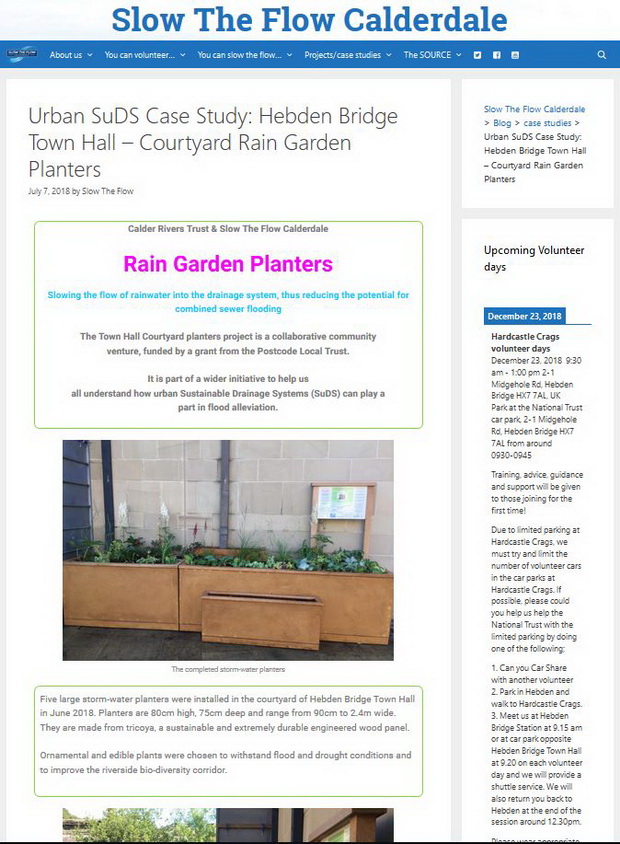
Image: Screenshot of case study on Slow The Flow: Calderdale web page.
A Community Flood Hub
Hebden Bridge Town Hall is a brilliantly appropriate venue for the showcase. It is a community hub in the truest sense of the word, being well-used by the vibrant and creative locals of the upper Calder Valley (with international recognition – see National Geographics’ Cool List 2019!).
The Town Hall was the first point of contact and sanctuary for many following the devastating flood of Boxing Day 2015. Therefore, it is heavily associated in the area with community resilience in the face of flooding, and the idea that small, unselfish actions can make a big difference.
Integrating SuDS in place making design
SuDS interventions, such as these planters, can of course have multiple Green Infrastructure benefits, in addition to their contribution to flood alleviation, when thoughtfully designed. For example, the Calder Rivers Trust, as lead client for the project, has inspired a planting palette that contributes to a riverside biodiversity corridor, and showcases the possibilities to local residents.
The plants provide a welcome contrast to the hard surfaces in the courtyard. On such a hot day as the launch party, they added a certain calming and cooling effect in the midst of all that stone and glass.
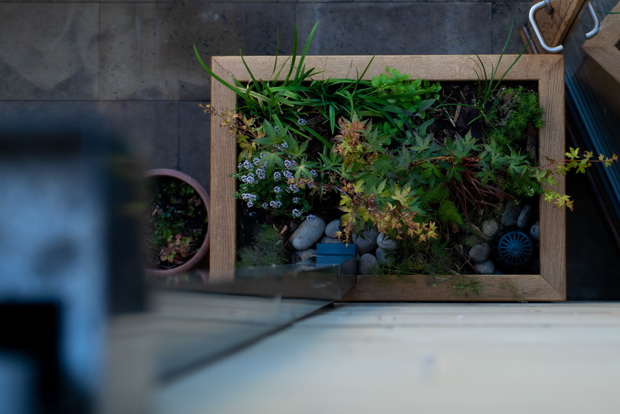
Image: Rain garden planter seen from balcony (credit: Matt Radcliffe Photography).
The rain garden planters collect water from most of the downpipes around the edges of the courtyard (some are part of the listed building, so we didn’t include those). The section used on the information panel shows diagrammatically how they take the water and slow it down, through splash blocks, plants, layers of soil and substrate, and finally collect any remaining run off using leaky pipes, taking it back into the drain.
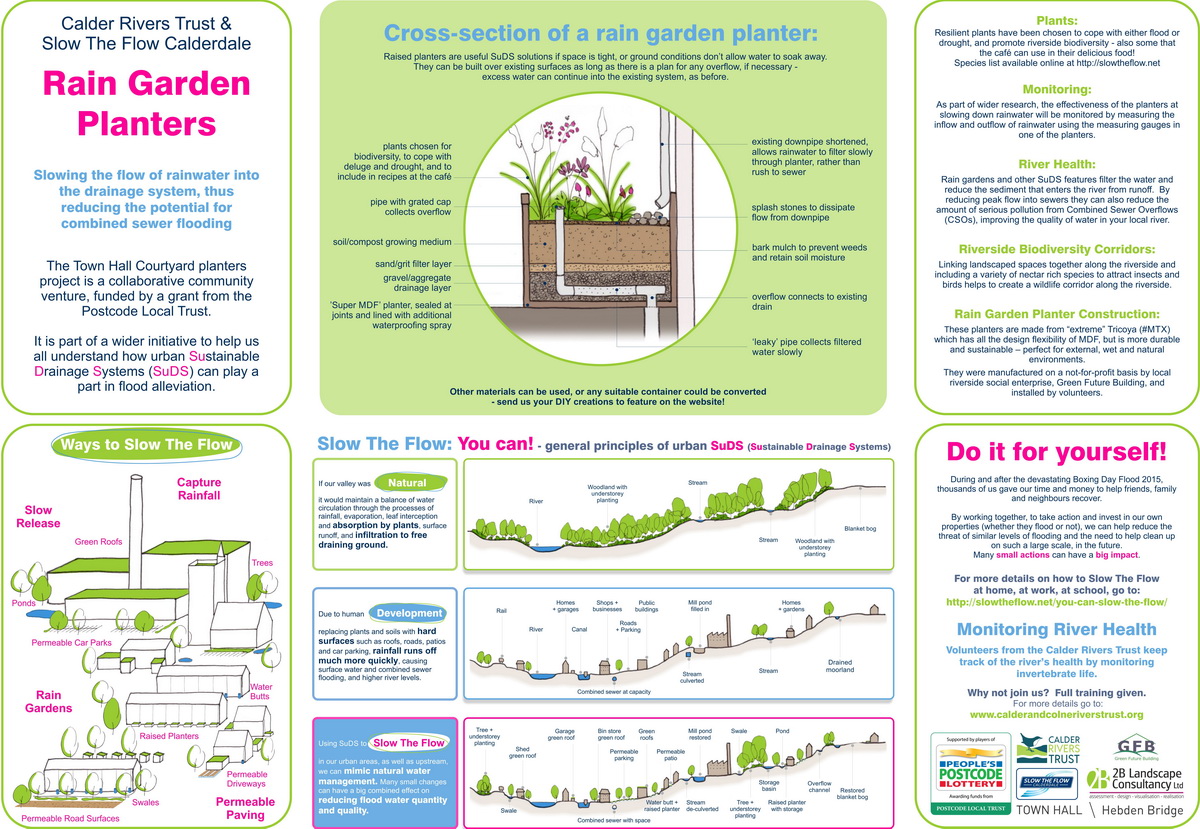
Image: Rain garden planter interpretation panel.
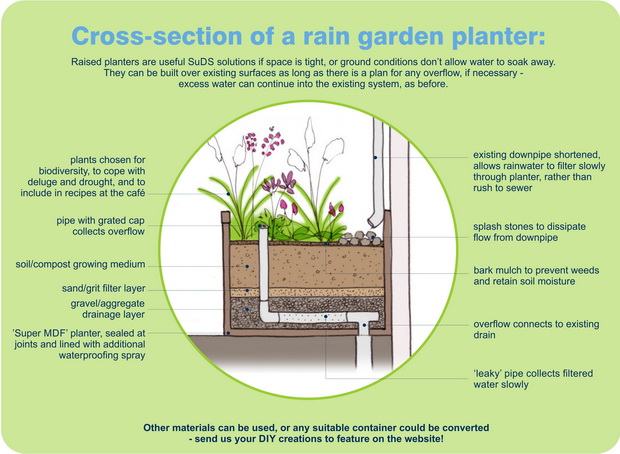
Image: Rain garden planter diagrammatic section.
A brilliant charitable project team
The planters were designed by 2B, and built in collaboration with a fantastic team of organisations doing good work in the Calder Valley. We were delighted to be a part of the build as volunteers, as well as managing the project.
We had a great time working with the Calder Rivers Trust, Hebden Bridge Community Association, Green Future Building, Calder Valley Clean Up, and The Basement Project – and the whole project was kindly funded by the Postcode Local Trust.
Monitoring the effectiveness of the rain garden planters
A key aspect of the project has been the R+D of a bespoke system for monitoring the effectiveness of the planters, by Geoff Sweaney of Wetland Engineering. We will have to wait for significant rainfall before we can test it, but we are looking forward to some projections that will attempt to quantify what difference this type of intervention can make in a flood event.
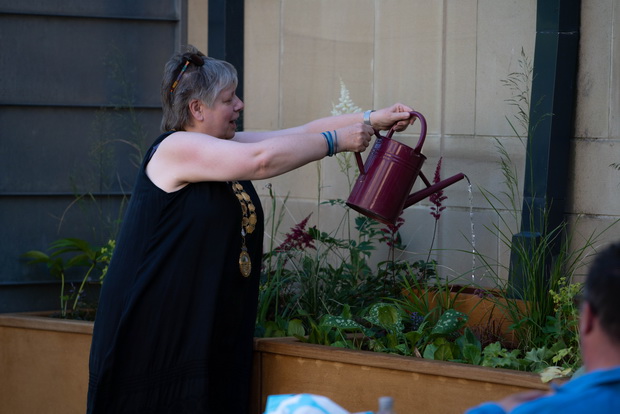
Image: Hebden Royd Mayor Carol Stow ‘opens’ the scheme by watering a rain garden planter using its monitoring system (credit: Matt Radcliffe Photography).
Watch this space for results! (We’ll report back here - you can follow the blog using the form below).
Amanda McDermott CMLI
Back to the top

Image: Rain garden planter launch party, seen from balcony (credit: Matt Radcliffe Photography).
The 'You Can Slow The Flow' project is designed to inform and empower the local community to make small changes in their own urban environment with the overall aim of slowing the flow of heavy rainfall events. This could have a big impact in the Calder catchment, which is described as ‘flashy’, meaning it responds dramatically to surface run off. In particular, SuDS systems can help to reduce the impact of overflow from Calderdale’s combined surface & foul sewers and therefore the risk of contaminated flood water entering homes and rivers.
Slow The Flow: Calderdale recognises that a great enough impact cannot be acheived by attempting to physically create enough SuDS interventions themselves (as a voluntary, non-land-owning organisation). They appreciate that what is needed is a shift in approach to a collective local mindset, whereby SuDS are considered the normal approach to develeopment, in order to help integrate SuDS as much as possible in Calderdale. This will need to include retrofit development, in addition to new build projects.
The planters at the Town Hall, then, although they will make some contribution to slowing the flow, are primarily an educational tool. They demonstrate the principles of SuDS, promote riverside biodiversity, and encourage the community to implement these types of urban NFM techniques as widely as possible.
The information project (which we have been involved in heavily from the start, due to my alter-ego as a founding trustee of Slow The Flow: Calderdale) was the recipient of the award for Sustainable Water Industry Group (SWIG) Awards for best project in 2017. It continues to go from strength to strength.
The planters now feature as a key case study on Slow The Flow’s new ‘case studies’ page.

Image: Screenshot of case study on Slow The Flow: Calderdale web page.
A Community Flood Hub
Hebden Bridge Town Hall is a brilliantly appropriate venue for the showcase. It is a community hub in the truest sense of the word, being well-used by the vibrant and creative locals of the upper Calder Valley (with international recognition – see National Geographics’ Cool List 2019!).
The Town Hall was the first point of contact and sanctuary for many following the devastating flood of Boxing Day 2015. Therefore, it is heavily associated in the area with community resilience in the face of flooding, and the idea that small, unselfish actions can make a big difference.
Integrating SuDS in place making design
SuDS interventions, such as these planters, can of course have multiple Green Infrastructure benefits, in addition to their contribution to flood alleviation, when thoughtfully designed. For example, the Calder Rivers Trust, as lead client for the project, has inspired a planting palette that contributes to a riverside biodiversity corridor, and showcases the possibilities to local residents.
The plants provide a welcome contrast to the hard surfaces in the courtyard. On such a hot day as the launch party, they added a certain calming and cooling effect in the midst of all that stone and glass.

Image: Rain garden planter seen from balcony (credit: Matt Radcliffe Photography).
The rain garden planters collect water from most of the downpipes around the edges of the courtyard (some are part of the listed building, so we didn’t include those). The section used on the information panel shows diagrammatically how they take the water and slow it down, through splash blocks, plants, layers of soil and substrate, and finally collect any remaining run off using leaky pipes, taking it back into the drain.

Image: Rain garden planter interpretation panel.

Image: Rain garden planter diagrammatic section.
A brilliant charitable project team
The planters were designed by 2B, and built in collaboration with a fantastic team of organisations doing good work in the Calder Valley. We were delighted to be a part of the build as volunteers, as well as managing the project.
We had a great time working with the Calder Rivers Trust, Hebden Bridge Community Association, Green Future Building, Calder Valley Clean Up, and The Basement Project – and the whole project was kindly funded by the Postcode Local Trust.
Monitoring the effectiveness of the rain garden planters
A key aspect of the project has been the R+D of a bespoke system for monitoring the effectiveness of the planters, by Geoff Sweaney of Wetland Engineering. We will have to wait for significant rainfall before we can test it, but we are looking forward to some projections that will attempt to quantify what difference this type of intervention can make in a flood event.

Image: Hebden Royd Mayor Carol Stow ‘opens’ the scheme by watering a rain garden planter using its monitoring system (credit: Matt Radcliffe Photography).
Watch this space for results! (We’ll report back here - you can follow the blog using the form below).
Amanda McDermott CMLI
Back to the top